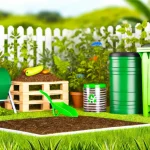
Are you tired of wasting water and harmful chemicals in your garden?
This introduction to sustainable gardening will show you simple, eco-friendly ways to create a thriving garden that’s kind to the environment. Let’s grow green together!
Sustainable Gardening involves using eco-friendly practices to grow plants, such as conserving water, composting, and using natural pest control. It promotes environmental health and plant resilience.
1. Introduction to Sustainable Gardening
Table of Contents
ToggleHey there, gardening enthusiasts! Welcome to the first step in creating a garden that’s not only beautiful but also kind to our planet.
This introduction to sustainable gardening will guide you through the basics, helping you grow a thriving garden while conserving resources and reducing waste.
Basics of Sustainable Gardening Practices: An Overview
Composting Methods:
Different Methods of Composting for the Garden
Composting is a fantastic way to recycle kitchen scraps and garden waste into nutrient-rich soil. You can try:
- Traditional Composting: A simple pile or bin where organic materials break down over time.
- Vermicomposting: Using worms to convert food waste into valuable compost.
- Bokashi Composting: A fermentation method that breaks down all types of food waste quickly.
Permaculture Principles:
Key Principles of Permaculture in Gardening
Permaculture focuses on designing gardens that mimic natural ecosystems. Key principles include:
- Observe and Interact: Understand your garden’s needs by observing its natural processes.
- Use Renewable Resources: Opt for sustainable materials and practices.
- Integrate Rather Than Segregate: Combine plants and animals that support each other’s growth.
Rainwater Harvesting:
Techniques for Harvesting Rainwater for Gardening
Rainwater harvesting is an excellent way to conserve water. Consider these methods:
- Rain Barrels: Collect runoff from your roof in barrels for garden use.
- Soakaway Pits: Direct rainwater into the ground to replenish groundwater.
- Swales: Contour your garden to channel rainwater to plants.
These basic practices lay the foundation for a sustainable garden that thrives naturally. Stay tuned for more tips on eco-friendly gardening!
Read more: Permaculture Gardening: Best Tips for Beginners – Sustainably Forward
2. Composting Methods

Composting is a fantastic way to turn kitchen scraps and garden waste into nutrient-rich soil, helping your garden thrive while reducing waste.
Let’s explore the different methods of composting that you can use in your sustainable garden.
Traditional Composting
Different Methods of Composting for the Garden
Traditional composting involves creating a pile or using a bin where organic materials like vegetable scraps, leaves, and grass clippings break down over time. Here are some key points:
- Layering: Alternate layers of green (nitrogen-rich) and brown (carbon-rich) materials.
- Turning: Regularly turning the compost helps aerate it and speed up decomposition.
- Moisture: Keep the compost moist but not too wet.
Vermicomposting
Vermicomposting uses worms to convert food waste into valuable compost. It’s a great option for smaller spaces or indoor composting. Here’s what you need to know:
- Worm Bin: Create or buy a worm bin with proper drainage and ventilation.
- Worms: Use red wigglers, as they are highly efficient at breaking down organic matter.
- Feeding: Feed your worms kitchen scraps like fruit peels, vegetable waste, and coffee grounds.
Bokashi Composting
Bokashi composting is a fermentation method that can handle all types of food waste, including meat and dairy. Here’s how it works:
- Bokashi Bin: Use a special bin with an airtight lid.
- Bokashi Bran: Sprinkle bokashi bran over food waste to initiate fermentation.
- Fermentation Process: After filling the bin, let it sit for a couple of weeks before burying the fermented waste in your garden soil.
Lasagna Composting
Lasagna composting, also known as sheet composting, involves layering organic materials directly onto the garden bed, creating a nutrient-rich foundation for plants. Here’s how to do it:
- Layering: Alternate layers of brown (leaves, cardboard) and green (kitchen scraps, grass clippings) materials.
- No Turning Required: Unlike traditional composting, lasagna composting doesn’t require turning.
- Build Up: Continue adding layers until the pile is about 2 feet high. Over time, it will break down and enrich the soil.
These composting methods are simple and effective ways to recycle organic waste into rich, fertile soil for your garden. Give one (or more) a try and see the benefits in your sustainable garden!
3. Permaculture Principles
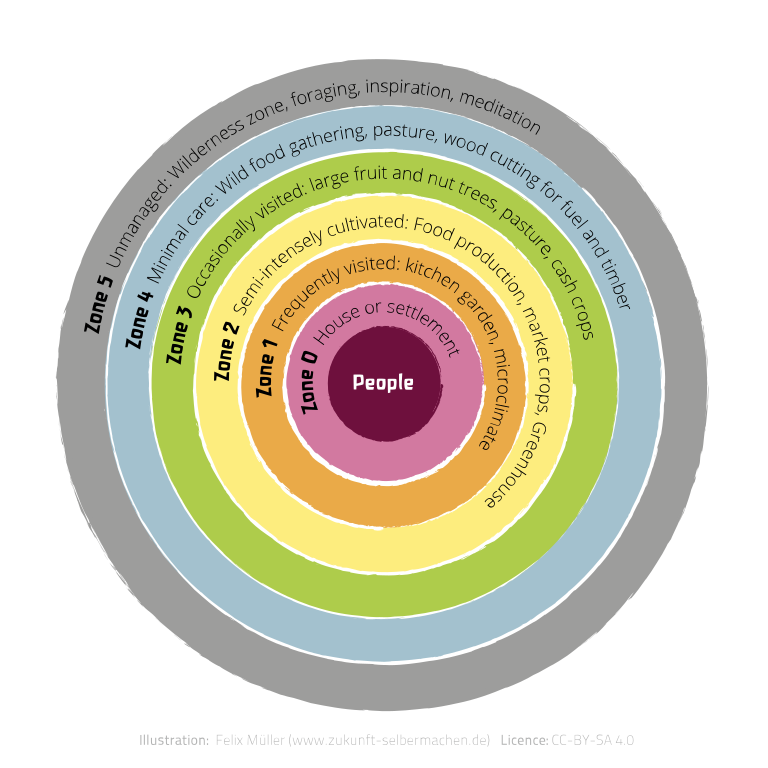
Permaculture is all about working with nature to create self-sustaining ecosystems in your garden. By applying these key principles, you can design a garden that thrives on its own, reduces waste, and promotes biodiversity.
Key Principles of Permaculture in Gardening
Observe and Interact
Understanding your garden’s natural processes is the first step in permaculture. Spend time observing the patterns and interactions in your garden. Notice how sunlight, water, and wind affect your plants, and use this information to make informed decisions.
Use Renewable Resources
In permaculture, it’s important to choose sustainable materials and practices. Here are a few ways to do this:
- Composting: Recycle organic waste to enrich your soil.
- Rainwater Harvesting: Collect and use rainwater to reduce reliance on municipal water supplies.
- Mulching: Use organic materials like straw or leaves to retain soil moisture and suppress weeds.
Integrate Rather Than Segregate
Combine plants and animals that support each other’s growth to create a balanced ecosystem. This can include:
- Companion Planting: Planting certain plants together to benefit each other.
- Polyculture: Growing a variety of plants in the same space to mimic natural diversity.
- Attract Beneficial Insects: Encourage insects like bees and ladybugs, which help with pollination and pest control.
Catch and Store Energy
Make the most of the resources available in your garden. For example:
- Solar Panels: Use solar energy to power garden tools or lights.
- Thermal Mass: Incorporate materials that store heat and release it slowly, like stones or water barrels, to extend the growing season.
Produce No Waste
Permaculture encourages using everything to its fullest potential. This includes:
- Upcycling: Repurposing old items into useful garden tools or decorations.
- Zero-Waste Gardening: Finding ways to use every part of a plant, from roots to leaves, to minimize waste.
By applying these permaculture principles, you can create a garden that is both productive and sustainable. It’s all about working with nature, rather than against it, to build a thriving, eco-friendly garden.
4. Rainwater Harvesting

Hey there, garden enthusiasts! If you’re looking to make the most of natural resources, rainwater harvesting is a game-changer.
Collecting rainwater not only conserves water but also provides your plants with fresh, chemical-free hydration.
Let’s dive into some easy and effective techniques for harvesting rainwater in your garden.
Techniques for Harvesting Rainwater for Gardening
Rain Barrels
Rain barrels are one of the simplest ways to collect rainwater. Here’s how you can set them up:
- Placement: Position rain barrels under downspouts to catch runoff from your roof.
- Installation: Connect a spigot to easily access the stored water for your garden.
- Maintenance: Keep the barrel covered to prevent debris and mosquitoes.
Soakaway Pits
Soakaway pits are great for directing rainwater back into the ground. Here’s what to do:
- Digging: Create a pit in your garden that can collect and absorb water.
- Filling: Line the pit with gravel or stones to enhance drainage.
- Positioning: Place the pit in areas where water tends to collect naturally.
Swales
Swales are shallow, water-holding ditches that help channel rainwater to your plants. Here’s how you can use them:
- Design: Dig shallow trenches along the contour of your garden.
- Function: Swales slow down water runoff and allow it to seep into the soil.
- Planting: Grow water-loving plants along the edges of the swales.
Rain Gardens
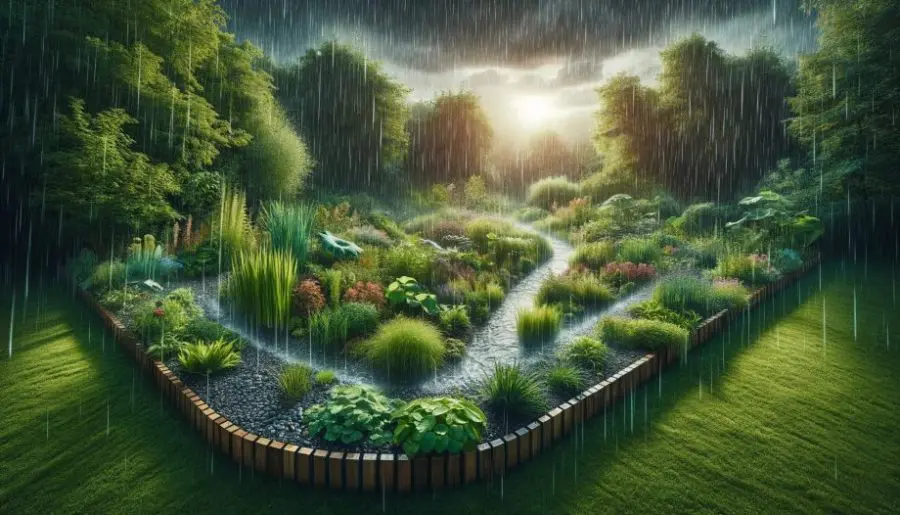
Rain gardens are designed to absorb and filter rainwater. Here’s how to create one:
- Location: Choose a low-lying area that receives runoff.
- Soil Prep: Amend the soil to improve drainage and water absorption.
- Plant Selection: Use native plants that thrive in wet conditions and help filter the water.
These rainwater harvesting techniques are simple yet effective ways to make your garden more sustainable.
Give them a try, and watch your garden flourish with nature’s gift!
5. Sustainable Soil Management

Hey garden pals! Keeping your soil healthy is the foundation of any thriving garden.
Sustainable soil management ensures your plants get the nutrients they need while being kind to the environment.
Let’s explore some eco-friendly practices to keep your soil in top shape.
Managing Soil Health in an Eco-Friendly Way
Composting
Composting is a fantastic way to enrich your soil naturally. Here’s how you can do it:
- Kitchen Scraps: Use vegetable peels, coffee grounds, and eggshells to create nutrient-rich compost.
- Garden Waste: Add leaves, grass clippings, and small branches to your compost pile.
- Turning: Regularly turn your compost to speed up decomposition and improve aeration.
Mulching
Mulching helps retain soil moisture, suppress weeds, and add organic matter to the soil. Here’s how to mulch effectively:
- Organic Mulch: Use straw, wood chips, or shredded leaves.
- Application: Spread mulch evenly around your plants, keeping it a few inches away from stems to prevent rot.
- Thickness: Apply a layer 2-3 inches thick to maximize benefits.
Cover Cropping
Cover crops protect and enrich your soil when your main crops aren’t growing. Here’s what to do:
- Selection: Choose cover crops like clover, rye, or vetch.
- Planting: Sow cover crops during off-seasons or between planting cycles.
- Benefits: Cover crops prevent erosion, fix nitrogen, and improve soil structure.
Crop Rotation
Rotating crops helps maintain soil fertility and reduce pest and disease buildup. Here’s how to implement crop rotation:
- Planning: Divide your garden into sections and rotate crops with different nutrient needs.
- Schedule: Change the location of crops each season to prevent nutrient depletion.
- Diversity: Include a variety of plants to support soil health.
Soil Testing
Regular soil testing helps you understand your soil’s nutrient levels and pH. Here’s how to do it:
- Kits: Use a home soil testing kit or send samples to a local extension service.
- Analysis: Test for key nutrients like nitrogen, phosphorus, and potassium.
- Amendments: Adjust your soil’s pH and nutrient levels based on test results.
By managing your soil health in an eco-friendly way, you’ll create a robust foundation for your garden, ensuring healthy plants and bountiful harvests. Happy gardening!
6. Organic Pest Control
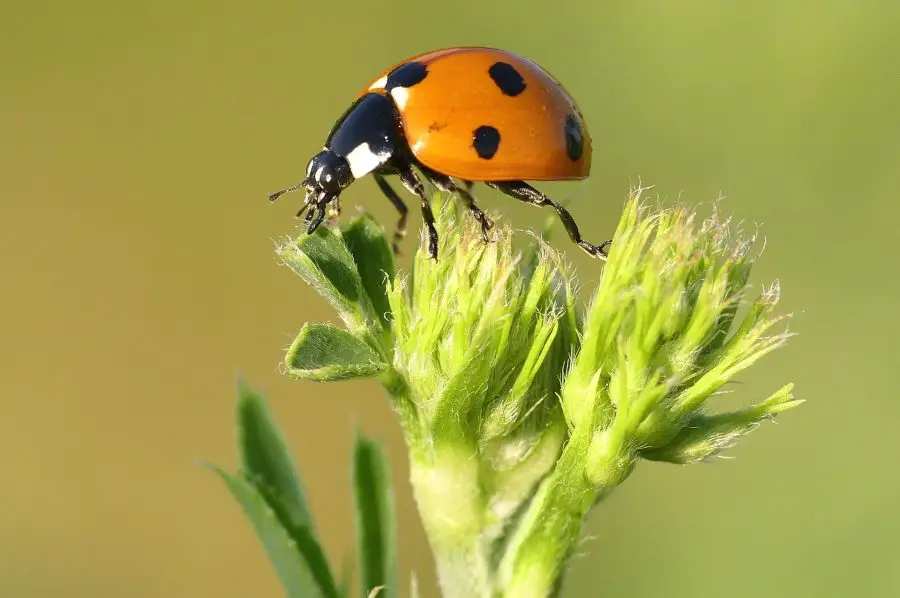
Dealing with pests in your garden can be a real challenge, but you don’t have to resort to harsh chemicals.
Organic pest control uses natural methods to keep those pesky bugs at bay while protecting your plants and the environment.
Let’s explore some effective techniques for natural pest control.
Natural Methods for Controlling Pests in the Garden
Beneficial Insects
One of the best ways to manage pests is by encouraging beneficial insects in your garden. Here’s how:
- Ladybugs: They devour aphids and other soft-bodied pests.
- Lacewings: These insects eat aphids, mites, and caterpillars.
- Hoverflies: Their larvae feed on aphids and other small insects.
Companion Planting
Companion planting involves growing plants together that help each other out. Here are some great combos:
- Marigolds: Plant marigolds near vegetables to repel nematodes and aphids.
- Basil: Grow basil with tomatoes to deter flies and mosquitoes.
- Nasturtiums: These flowers attract aphids away from your veggies.
Neem Oil
Neem oil is a natural pesticide derived from the neem tree. It works well against a variety of pests. Here’s how to use it:
- Mixing: Dilute neem oil with water according to the label instructions.
- Application: Spray the mixture on affected plants, covering all surfaces.
- Timing: Apply in the early morning or late evening to avoid harming beneficial insects.
Diatomaceous Earth
Diatomaceous earth is a powder made from fossilized algae. It’s great for controlling pests like slugs and beetles. Here’s how to use it:
- Sprinkling: Dust the powder around the base of your plants and directly on pests.
- Reapplication: Reapply after rain or watering, as it loses effectiveness when wet.
- Safety: Use food-grade diatomaceous earth to ensure safety for you and your plants.
Garlic and Pepper Spray
A homemade garlic and pepper spray can deter a wide range of pests. Here’s a simple recipe:
- Ingredients: Blend a few garlic cloves, hot peppers, and water.
- Straining: Strain the mixture and add a few drops of dish soap.
- Spraying: Apply the spray to your plants, focusing on areas with pest problems.
Handpicking
Sometimes the simplest method is the best. Handpicking larger pests like caterpillars and beetles can be very effective. Here’s what to do:
- Inspect: Regularly check your plants for pests.
- Remove: Pick off any pests you find and dispose of them.
- Consistency: Be diligent and check your garden frequently.
By using these natural methods, you can control pests in your garden while keeping your plants and the environment safe and healthy. Happy gardening, and may your plants stay pest-free!
7. Companion Planting
Companion planting is like having your plants team up to help each other grow strong and healthy.
By choosing the right plant buddies, you can boost growth, repel pests, and improve soil health.
Let’s dive into the benefits and techniques of companion planting.
Benefits of Companion Planting
Pest Control: Some plants naturally repel pests that would otherwise harm their neighbors. For example:
- Marigolds: These bright flowers deter nematodes and aphids.
- Basil: Planting basil near tomatoes can help keep flies and mosquitoes at bay.
- Nasturtiums: They act as a trap crop, luring aphids away from your main plants.
Improved Growth: Certain plant combinations can enhance each other’s growth. Examples include:
- Three Sisters: Corn, beans, and squash grow well together. Corn provides support for beans, beans add nitrogen to the soil, and squash shades the ground, reducing weeds.
- Radishes and Carrots: Radishes loosen the soil, making it easier for carrots to grow.
Soil Health: Companion planting can improve soil structure and fertility. Consider these pairings:
- Legumes and Grains: Beans and peas fix nitrogen in the soil, benefiting heavy feeders like corn and wheat.
- Herbs and Vegetables: Herbs like dill and cilantro attract beneficial insects and improve soil health.
Techniques of Companion Planting
Interplanting: Mix different plants within the same bed to maximize space and resources. Here’s how to do it:
- Spacing: Plant smaller, fast-growing crops like lettuce between larger, slower-growing plants like tomatoes.
- Timing: Stagger planting times to ensure that plants don’t compete for resources at the same time.
Trap Cropping: Use sacrificial plants to attract pests away from your main crops. Here’s how to implement this:
- Planting: Grow trap crops like nasturtiums or mustard near vulnerable plants.
- Maintenance: Monitor trap crops and remove pests as needed.
Guild Planting: Create plant communities that benefit each other, known as guilds. Here’s an example:
- Fruit Tree Guild: Surround a fruit tree with nitrogen-fixing plants (clover), pest-repellent herbs (garlic), and mulch plants (comfrey) to support the tree’s health.
Succession Planting: Plan for continuous harvests by planting crops in succession. Here’s how:
- Planning: Start with cool-season crops (lettuce, spinach), follow with warm-season crops (tomatoes, peppers), and finish with fall crops (kale, broccoli).
- Overlap: Overlap planting times so that as one crop finishes, another is ready to take its place.
By using these companion planting techniques, you can create a more resilient and productive garden.
Happy planting, and may your garden buddies thrive together!
8. Native Plants
Using native plants in your garden is a fantastic way to support local wildlife and create a sustainable, low-maintenance garden.
Native plants are adapted to your local climate and soil, making them easier to grow and maintain.
Let’s explore how using native plants can promote biodiversity and sustainability.
Using Native Plants to Promote Biodiversity and Sustainability
Benefits of Native Plants
Supports Local Wildlife: Native plants provide food and habitat for local birds, insects, and other wildlife. Here’s how:
- Pollinators: Native flowers attract bees, butterflies, and other pollinators.
- Birds: Native shrubs and trees offer shelter and food for birds.
- Beneficial Insects: Native plants attract insects that control pests naturally.
Low Maintenance:
Because they are adapted to your region, native plants typically require less water, fertilizer, and pest control. This makes them:
- Drought-Resistant: They thrive with natural rainfall.
- Pest-Resistant: They are less likely to be affected by local pests and diseases.
- Soil-Adaptive: They grow well in local soil conditions without needing amendments.
Environmental Benefits:
Native plants help improve the environment in several ways:
- Soil Health: Their deep roots improve soil structure and prevent erosion.
- Water Conservation: They reduce the need for irrigation, conserving water.
- Carbon Sequestration: Trees and shrubs capture and store carbon, helping combat climate change.
Techniques for Using Native Plants
Research and Selection:
Start by identifying native plants that thrive in your area. Here’s how:
- Local Extension Services: Contact local agricultural extension offices for lists of native plants.
- Native Plant Nurseries: Visit nurseries that specialize in native species.
- Online Resources: Use websites dedicated to native plants to find suitable species.
Designing with Native Plants:
Incorporate native plants into your garden design. Here are some ideas:
- Pollinator Gardens: Create a garden with a variety of native flowers that bloom at different times to provide a continuous food source for pollinators.
- Wildlife Habitats: Include a mix of native trees, shrubs, and groundcovers to create habitats for birds and other wildlife.
- Natural Landscaping: Use native plants to create natural-looking landscapes that blend seamlessly with the surrounding environment.
Planting and Maintenance:
Once you’ve selected your plants, it’s time to get them in the ground. Here’s what to do:
- Planting Time: Plant native species during their optimal planting season, usually in the fall or spring.
- Watering: Water newly planted natives until they are established. After that, they should thrive with minimal watering.
- Pruning and Care: Prune and care for native plants as needed, but remember they generally require less maintenance than non-natives.
Using native plants is a win-win for your garden and the environment.
They make your garden more resilient, attract beneficial wildlife, and help preserve local ecosystems. Happy gardening with natives!
9. Edible Landscaping
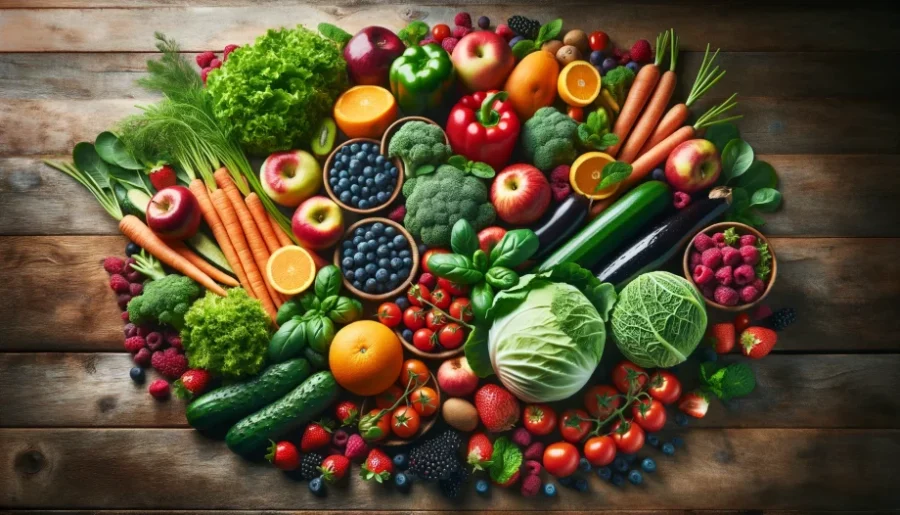
Edible landscaping combines the beauty of ornamental plants with the practicality of growing your own food.
By designing a landscape that produces food, you can enjoy fresh fruits, vegetables, and herbs right from your garden while creating a stunning outdoor space.
Let’s dig into some tips and ideas for edible landscaping.
Designing a Landscape That Produces Food
Benefits of Edible Landscaping
Aesthetic Appeal: Edible plants can be just as beautiful as ornamental ones. Here’s why:
- Variety: Colorful vegetables, fruits, and herbs add visual interest.
- Textures: Different plant textures create a rich, layered look.
- Flowers: Many edible plants, like chives and nasturtiums, have attractive flowers.
Practicality: Growing your own food reduces grocery bills and provides fresh, nutritious produce. Benefits include:
- Convenience: Fresh herbs and veggies are always within reach.
- Nutrition: Home-grown produce is often more nutritious and flavorful.
- Sustainability: Reduces the carbon footprint by eliminating the need for transport.
Design Tips for Edible Landscaping
Plan Your Layout: Consider both aesthetics and practicality. Here’s how to start:
- Zones: Designate areas for different types of plants, such as vegetables, fruits, and herbs.
- Sunlight: Plant sun-loving edibles in sunny spots and shade-tolerant ones in shadier areas.
- Accessibility: Ensure paths and walkways allow easy access to all parts of your garden.
Incorporate Edibles with Ornamentals: Mix edible plants with decorative ones for a cohesive look. Some ideas include:
- Border Plants: Use herbs like rosemary and lavender as border plants.
- Climbers: Grow climbing edibles like beans and peas on trellises or fences.
- Groundcovers: Use low-growing edibles like thyme and strawberries as groundcovers.
Choose Multi-Purpose Plants: Select plants that offer multiple benefits. Here are a few examples:
- Fruit Trees: Provide shade, beauty, and delicious fruit.
- Herbs: Many herbs are both culinary and medicinal, adding value to your garden.
- Perennials: Plant perennial edibles like asparagus and rhubarb for year-after-year harvests.
Create Focal Points: Make your garden visually interesting with edible focal points. Consider these options:
- Fruit Trees: Plant a beautiful apple or cherry tree as a centerpiece.
- Raised Beds: Use raised beds for vegetables, adding structure and height.
- Herb Spirals: Build an herb spiral to save space and create a striking feature.
Maintenance and Care
Watering: Regular watering is essential for healthy plants. Here are some tips:
- Drip Irrigation: Use drip irrigation to deliver water directly to the roots.
- Mulching: Mulch around plants to retain moisture and reduce weeds.
Soil Health: Keep your soil rich and fertile with these practices:
- Composting: Add compost to your soil to improve fertility.
- Crop Rotation: Rotate crops to prevent nutrient depletion and reduce pests.
Pest Management: Protect your plants from pests using natural methods:
- Companion Planting: Plant pest-repellent herbs like basil and marigolds.
- Beneficial Insects: Attract beneficial insects like ladybugs and lacewings.
Edible landscaping is a wonderful way to combine beauty and functionality in your garden.
By integrating edible plants into your landscape, you can enjoy fresh, home-grown food while creating a gorgeous outdoor space.
Happy gardening, and enjoy the fruits of your labor!
10. Urban Gardening

Howdy, city gardeners! Urban gardening is all about making the most of small spaces to grow your own food and greenery.
Whether you have a tiny balcony or a small backyard, you can still create a thriving garden.
Let’s explore some tips and techniques to help you succeed in urban gardening.
Tips and Techniques for Urban Gardening
Maximize Space
Vertical Gardening: Utilize vertical space to grow more plants. Here’s how:
- Trellises and Arbors: Grow climbing plants like tomatoes, cucumbers, and beans.
- Hanging Baskets: Use hanging baskets for strawberries, herbs, and flowers.
- Wall Planters: Install wall-mounted planters for a variety of herbs and small vegetables.
Container Gardening: Perfect for balconies and patios. Tips include:
- Pot Selection: Choose pots with good drainage and appropriate size for the plants.
- Soil Mix: Use high-quality potting soil mixed with compost for nutrients.
- Mobility: Place containers on wheeled stands to move them easily for sunlight or shelter.
Grow Upwards: Use stackable planters or shelves to grow more in less space.
Optimize Sunlight
Sunlight Exposure: Ensure your plants get enough light. Here’s how:
- Location: Place plants where they receive at least 6 hours of sunlight daily.
- Reflectors: Use reflective surfaces to increase light for plants in shady areas.
- LED Grow Lights: Supplement natural light with LED grow lights, especially for indoor gardens.
Soil and Fertilization
Soil Quality: Good soil is crucial for healthy plants. Here’s what to do:
- Container Soil: Use a mix designed for containers, which retains moisture and drains well.
- Soil Testing: Test your soil and amend it with compost or organic fertilizers as needed.
Fertilization: Feed your plants to keep them healthy. Here are some tips:
- Organic Fertilizers: Use organic options like fish emulsion, worm castings, or compost tea.
- Regular Feeding: Fertilize according to the needs of the plants, typically every few weeks.
Watering
Efficient Watering: Urban gardens often require more frequent watering. Here’s how to do it efficiently:
- Self-Watering Containers: Use containers with built-in reservoirs to reduce watering frequency.
- Drip Irrigation: Install a drip irrigation system to deliver water directly to the roots.
- Water Conservation: Collect rainwater in barrels for irrigation.
Plant Selection
Choose Suitable Plants: Select plants that thrive in small spaces. Here are some good choices:
- Herbs: Basil, mint, parsley, and thyme grow well in pots and small spaces.
- Vegetables: Cherry tomatoes, peppers, lettuce, and radishes are ideal for containers.
- Fruits: Dwarf varieties of strawberries, blueberries, and citrus trees can be grown in pots.
Pest Control
Natural Methods: Keep pests at bay without chemicals. Here’s how:
- Companion Planting: Grow pest-repellent plants like marigolds and garlic near your crops.
- Neem Oil: Use neem oil spray to control pests naturally.
- Beneficial Insects: Attract ladybugs and other beneficial insects to help manage pest populations.
Community Gardening
Get Involved: Join or start a community garden. Benefits include:
- Shared Resources: Access to tools, knowledge, and shared space.
- Social Interaction: Connect with fellow gardeners and share tips and produce.
- Learning Opportunities: Learn new gardening techniques and gain inspiration from others.
Urban gardening allows you to enjoy fresh produce and beautiful plants, no matter how limited your space may be.
With these tips and techniques, you’ll be well on your way to creating a vibrant urban garden. Happy gardening!
11. Vertical Gardening

Hey there, space-saving gardeners! Vertical gardening is a fantastic way to maximize your growing area, especially if you’re working with limited space.
By growing upwards, you can create a lush, productive garden without taking up much ground space.
Let’s explore some creative vertical gardening ideas to help you get started.
Space-Saving Vertical Gardening Ideas
Trellises and Arbors
Using trellises and arbors allows climbing plants to grow vertically. Here’s how:
- Climbing Vegetables: Grow peas, beans, and cucumbers on sturdy trellises.
- Decorative Arbors: Use arbors to support flowering vines like clematis and wisteria.
- DIY Trellises: Create your own trellises using materials like bamboo or repurposed wood.
Hanging Baskets
Hanging baskets are perfect for small spaces like balconies. Here’s what to plant:
- Herbs: Basil, thyme, and mint thrive in hanging baskets.
- Strawberries: Enjoy fresh strawberries from cascading plants.
- Flowers: Add color with flowering plants like petunias and fuchsias.
Wall Planters
Transform walls into productive garden spaces with wall planters. Here’s how:
- Vertical Planter Systems: Use pre-made vertical planter systems for easy setup.
- Pallet Gardens: Repurpose wooden pallets into wall planters for herbs and small veggies.
- Pocket Planters: Fabric pocket planters are great for growing a variety of plants vertically.
Stackable Planters
Stackable planters allow you to grow more in less space by layering plants. Here’s what to try:
- Strawberry Towers: Stackable planters are perfect for growing strawberries.
- Herb Towers: Grow a variety of herbs in a compact, vertical space.
- Vegetable Towers: Use stackable systems to grow small vegetables like lettuce and spinach.
Living Walls
Living walls, or green walls, are a striking way to grow plants vertically. Here’s how to create one:
- Modular Panels: Use modular panel systems that hold soil and plants.
- Irrigation: Install a drip irrigation system to ensure even watering.
- Plant Selection: Choose a mix of plants that thrive in vertical environments, such as ferns, ivy, and succulents.
Vertical Hydroponics
Vertical hydroponic systems are ideal for maximizing space and efficiency. Here’s how they work:
- Nutrient Film Technique (NFT): This method uses a thin film of nutrient-rich water to feed plants.
- Tower Gardens: Vertical towers with slots for individual plants, circulating nutrient solution.
- Benefits: Hydroponics allows for faster growth and higher yields in a smaller footprint.
A-Frame Structures
A-frame structures provide ample vertical growing space. Here’s how to use them:
- Construction: Build A-frames from wood or metal for sturdy support.
- Planting: Grow trailing plants like squash, melons, and tomatoes.
- Mobility: A-frame structures can be easily moved to optimize sunlight exposure.
Upcycled Materials
Get creative with upcycled materials to build vertical gardens. Here’s what to use:
- Gutters: Mount old gutters on walls to grow herbs and small plants.
- PVC Pipes: Create vertical planters from PVC pipes with drilled holes for plants.
- Ladders: Repurpose an old ladder as a tiered plant stand.
Vertical gardening is a smart and stylish way to make the most of your gardening space.
With these ideas, you can create a lush, productive garden that grows up rather than out. Happy vertical gardening!
12. Container Gardening

Container gardening is perfect for those with limited space, allowing you to grow a variety of plants in pots and containers.
Plus, it’s easy to manage and can be incredibly sustainable. Let’s dive into some sustainable practices for container gardening to help you create a thriving, eco-friendly garden.
Sustainable Practices for Container Gardening
Choosing Containers
Selecting the right containers is the first step to successful container gardening. Here’s how to make sustainable choices:
- Repurposed Containers: Use items like old buckets, crates, and barrels as plant containers.
- Biodegradable Pots: Choose pots made from materials like coir, peat, or biodegradable plastics.
- Durable Materials: Opt for long-lasting materials such as ceramic, metal, or high-quality plastic to reduce waste.
Soil and Compost
Using the right soil mix is crucial for container gardening. Here’s how to ensure it’s sustainable:
- Organic Potting Mix: Use organic potting mix free from synthetic chemicals.
- Homemade Compost: Mix your homemade compost with potting soil to add nutrients.
- Soil Reuse: Reuse soil from previous growing seasons by refreshing it with compost and organic fertilizers.
Watering Practices
Efficient watering helps conserve water and keeps your plants healthy. Here are some tips:
- Self-Watering Containers: Use containers with built-in reservoirs to reduce watering frequency.
- Drip Irrigation: Set up a drip irrigation system to deliver water directly to the plant roots.
- Mulching: Apply a layer of mulch on top of the soil to retain moisture and reduce evaporation.
Fertilization
Feeding your container plants sustainably is key to their growth. Here’s how:
- Organic Fertilizers: Use natural fertilizers like fish emulsion, seaweed extract, or compost tea.
- Slow-Release Options: Choose slow-release organic fertilizers to provide steady nutrients over time.
- Homemade Solutions: Make your own liquid fertilizers from compost or manure tea.
Plant Selection
Choosing the right plants can make your container garden more sustainable. Consider these options:
- Native Plants: Select native plants that are adapted to your local climate and soil conditions.
- Drought-Tolerant Plants: Opt for plants that require less water, such as succulents and Mediterranean herbs.
- Perennials: Grow perennial plants that come back year after year, reducing the need for replanting.
Pest Management
Managing pests sustainably helps keep your container garden healthy. Here’s how:
- Natural Predators: Encourage beneficial insects like ladybugs and lacewings to control pests.
- Neem Oil: Use neem oil as a natural pesticide to keep pests at bay.
- Companion Planting: Grow companion plants that repel pests, such as basil with tomatoes or marigolds with vegetables.
Recycling and Upcycling
Incorporate recycling and upcycling into your container gardening practices. Here are some ideas:
- Reuse Containers: Reuse old containers for new plants, and clean them thoroughly between uses.
- Upcycle Materials: Turn household items like old boots, tea kettles, or even furniture into unique plant containers.
- Recycling: Recycle plant labels, old pots, and other gardening materials whenever possible.
Container gardening is a fantastic way to grow your own food and flowers in a sustainable manner, no matter how small your space is.
With these practices, you can create a productive and eco-friendly container garden that brings joy and beauty to your home.
Happy container gardening!
13. Greenhouses and Cold Frames
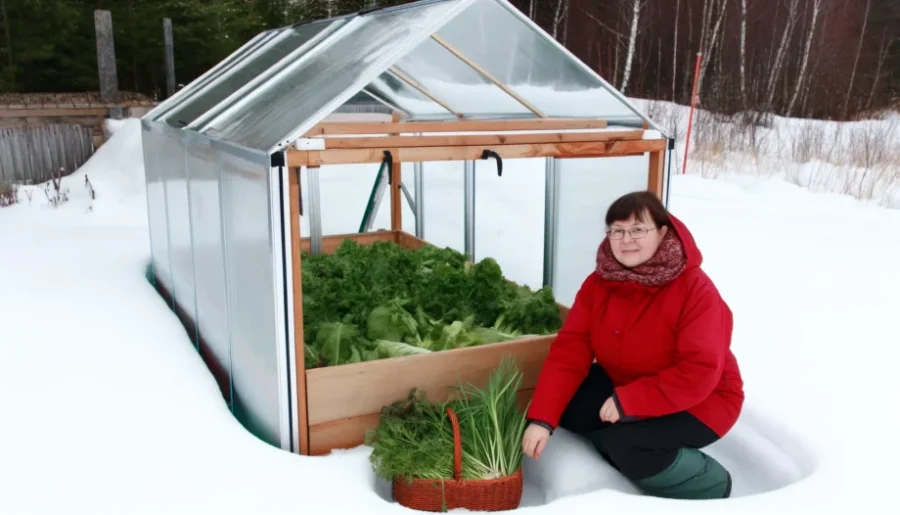
Howdy, garden enthusiasts! Greenhouses and cold frames are fantastic tools for extending your growing season and protecting plants from harsh weather.
When used sustainably, they can help you grow more while minimizing environmental impact.
Let’s explore some tips for using greenhouses and cold frames in an eco-friendly way.
Using Greenhouses and Cold Frames Sustainably
Choosing Materials
Selecting sustainable materials for your greenhouse or cold frame is the first step. Here’s how:
- Recycled Materials: Use recycled or repurposed materials like old windows, doors, or salvaged wood to build your structures.
- Durable Options: Opt for long-lasting materials such as polycarbonate panels or treated wood to ensure your greenhouse or cold frame stands the test of time.
- Natural Insulation: Use natural insulation materials like straw bales or recycled bubble wrap to keep your greenhouse warm.
Energy Efficiency
Maintaining an energy-efficient greenhouse or cold frame helps reduce your environmental footprint. Here are some tips:
- Passive Solar Design: Position your greenhouse to maximize sunlight exposure, and use thermal mass materials like water barrels or stones to store and release heat.
- Ventilation: Ensure proper ventilation to regulate temperature and humidity, reducing the need for additional heating or cooling.
- Energy-Efficient Heating: If supplemental heating is necessary, use energy-efficient options like solar heaters or compost-heated beds.
Water Conservation
Efficient water use is crucial for sustainable greenhouse and cold frame gardening. Here’s how to save water:
- Rainwater Harvesting: Collect rainwater from the greenhouse roof in barrels and use it to water your plants.
- Drip Irrigation: Install a drip irrigation system to deliver water directly to the roots, minimizing waste.
- Mulching: Apply mulch to the soil in your greenhouse to retain moisture and reduce evaporation.
Soil and Fertilization
Maintaining healthy soil and fertilizing sustainably are key to productive greenhouse and cold frame gardening. Here’s what to do:
- Organic Soil: Use organic potting mix and amend it with homemade compost or well-rotted manure.
- Crop Rotation: Practice crop rotation within your greenhouse to prevent soil depletion and reduce pest and disease buildup.
- Natural Fertilizers: Use organic fertilizers like fish emulsion, seaweed extract, or compost tea to feed your plants.
Pest Management
Keep pests at bay using natural methods to maintain a healthy growing environment. Here are some strategies:
- Beneficial Insects: Introduce beneficial insects like ladybugs and predatory mites to control pests naturally.
- Neem Oil: Use neem oil as a natural pesticide to keep your plants pest-free.
- Companion Planting: Grow pest-repellent plants like marigolds and basil alongside your crops to deter unwanted insects.
Season Extension
Maximize your growing season sustainably with these techniques:
- Cold Frames: Use cold frames to harden off seedlings in the spring and extend the growing season in the fall.
- Row Covers: Utilize row covers inside your greenhouse for added frost protection.
- Succession Planting: Plan succession planting schedules to make the most of your greenhouse space year-round.
By using greenhouses and cold frames sustainably, you can enjoy fresh produce and flowers throughout the year while minimizing your environmental impact.
These tips will help you create a productive and eco-friendly growing environment. Happy gardening in your greenhouses and cold frames!
14. No-Till Gardening
No-till gardening is a fantastic way to improve soil health and reduce labor while fostering a thriving garden.
By minimizing soil disturbance, you can promote a healthier ecosystem for your plants.
Let’s explore the benefits and methods of no-till gardening to get you started.
Benefits and Methods of No-Till Gardening
Benefits of No-Till Gardening
Improved Soil Health: No-till gardening enhances soil structure and fertility. Here’s how:
- Soil Structure: Leaving the soil undisturbed helps maintain its natural structure, which supports healthy root systems.
- Organic Matter: No-till practices increase organic matter in the soil, improving its ability to retain moisture and nutrients.
- Microbial Life: Minimizing disturbance helps protect the beneficial microorganisms that play a crucial role in soil health.
Reduced Erosion: No-till gardening helps prevent soil erosion by maintaining a protective cover. Here’s why it works:
- Cover Crops: Using cover crops keeps the soil covered and reduces erosion from wind and rain.
- Mulch: Mulching with organic materials like straw or leaves protects the soil surface and reduces runoff.
Less Labor: No-till gardening can save you time and effort. Here’s how it makes gardening easier:
- Weed Suppression: Mulching and cover cropping reduce weed growth, cutting down on weeding time.
- Soil Preparation: Without the need to till, you can skip the heavy lifting and go straight to planting.
Methods of No-Till Gardening
Mulching
Mulching is a key practice in no-till gardening. Here’s how to do it:
- Materials: Use organic mulches like straw, leaves, grass clippings, or wood chips.
- Application: Spread a thick layer of mulch (2-4 inches) over your garden beds, ensuring the soil is well-covered.
- Maintenance: Replenish the mulch as it decomposes to keep the soil protected and enriched.
Cover Cropping
Cover cropping involves planting specific crops to protect and enrich the soil. Here’s what to do:
- Selection: Choose cover crops like clover, rye, or vetch that fix nitrogen and improve soil health.
- Planting: Sow cover crops in the off-season or between main crops.
- Termination: Cut down cover crops before they go to seed, and leave the residue on the soil surface as mulch.
Lasagna Gardening
Lasagna gardening, also known as sheet composting, builds soil layers directly on top of existing soil. Here’s how:
- Layering: Alternate layers of brown (cardboard, straw) and green (kitchen scraps, grass clippings) materials.
- Building: Continue adding layers until the pile is about 2 feet high. Over time, it will break down and enrich the soil.
- Planting: Plant directly into the lasagna bed once the materials have decomposed sufficiently.
Direct Planting
Planting directly into the soil without tilling is a straightforward approach. Here’s how to get started:
- Preparation: Clear the planting area of large debris and weeds.
- Digging Holes: Use a garden trowel or dibber to dig planting holes for your seeds or seedlings.
- Mulching: Apply mulch around the plants to suppress weeds and retain moisture.
Compost Addition
Adding compost to the soil surface helps improve fertility without disturbing the soil. Here’s how:
- Spreading: Spread a layer of compost (1-2 inches) over your garden beds.
- Top-Dressing: Apply compost as a top-dressing around existing plants to provide ongoing nutrients.
- No Digging: Let natural processes incorporate the compost into the soil over time.
By embracing no-till gardening, you can create a healthier, more sustainable garden with less effort.
These benefits and methods will help you get started on your no-till journey.
15. Seed Saving
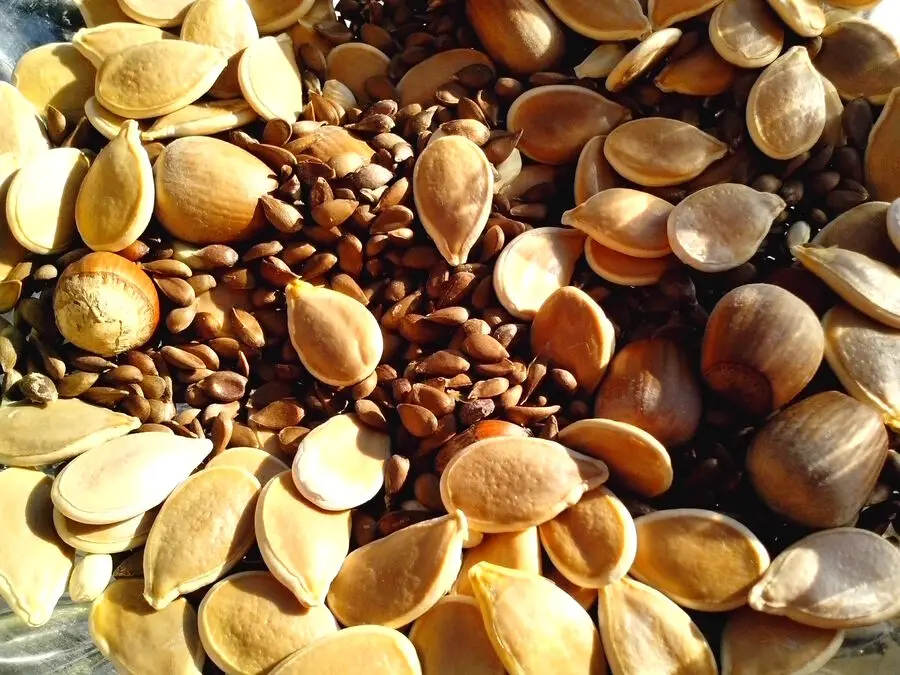
Saving seeds from your garden is a rewarding and sustainable practice that allows you to grow your favorite plants year after year.
By learning the techniques for seed saving, you can ensure a continuous supply of your preferred varieties and contribute to preserving plant biodiversity.
Let’s dive into some effective methods for saving seeds from your garden.
Techniques for Saving Seeds from Your Garden
Choosing the Right Plants
Start by selecting the best plants for seed saving. Here’s what to consider:
- Heirloom Varieties: Choose open-pollinated heirloom varieties, as their seeds produce plants true to type.
- Healthy Plants: Save seeds from your healthiest, most vigorous plants to ensure strong offspring.
- Isolate Varieties: To maintain pure strains, avoid cross-pollination by isolating different varieties of the same species.
Harvesting Seeds
Harvesting seeds at the right time is crucial for successful seed saving. Here’s how:
- Dry Seeds: For plants like beans, peas, and lettuce, allow seeds to mature and dry on the plant before harvesting.
- Wet Seeds: For plants like tomatoes, cucumbers, and squash, scoop out the seeds from ripe fruits and separate them from the pulp.
- Seed Heads: For plants like sunflowers and dill, wait until the seed heads are dry and the seeds easily come off.
Cleaning Seeds
Cleaning seeds properly ensures good storage and germination rates. Here’s how to clean different types of seeds:
- Dry Seeds: Shake or rub dry seeds to remove any chaff or plant debris. Use a screen or sieve to help separate the seeds.
- Wet Seeds: Rinse wet seeds in water to remove any remaining pulp. For tomatoes, ferment the seeds in water for a few days to remove the gelatinous coating.
- Large Seeds: For larger seeds like squash, wash them thoroughly and let them dry completely.
Drying Seeds
Proper drying is essential to prevent mold and ensure longevity. Here’s what to do:
- Air Drying: Spread seeds in a single layer on a paper towel, mesh screen, or plate. Place them in a warm, dry, and well-ventilated area.
- Drying Time: Allow seeds to dry for one to two weeks. Make sure they are completely dry before storing them.
- Avoid Heat: Do not use direct sunlight or high heat, as it can damage the seeds.
Storing Seeds
Storing seeds correctly keeps them viable for future planting. Here’s how:
- Containers: Store seeds in airtight containers like glass jars, envelopes, or plastic bags. Label each container with the plant name and harvest date.
- Cool and Dry: Keep seeds in a cool, dry place. A refrigerator or a dark, cool pantry is ideal.
- Desiccants: Include desiccants like silica gel packets or powdered milk in the storage containers to absorb moisture.
Testing Seed Viability
Testing the viability of your saved seeds ensures successful germination. Here’s a simple method:
- Sample Testing: Place a few seeds on a damp paper towel and fold it over. Keep the towel moist and in a warm place.
- Observation: Check for germination after a few days. A high germination rate indicates good seed viability.
Renewing Seed Stock
Regularly renewing your seed stock keeps your collection fresh. Here’s how:
- Annual Saving: Save seeds from your plants each year to maintain a viable seed supply.
- Diverse Collection: Save seeds from a variety of plants to ensure genetic diversity and adaptability.
By mastering these seed saving techniques, you can enjoy the benefits of a self-sustaining garden and preserve your favorite plant varieties for years to come. Happy seed saving!
16. Aquaponics and Hydroponics

Aquaponics and hydroponics are innovative and sustainable ways to grow plants without traditional soil.
These systems can save water, reduce waste, and produce healthy plants quickly.
Let’s explore how you can set up and maintain sustainable aquaponics and hydroponics systems in your garden.
Sustainable Aquaponics and Hydroponics Systems
Aquaponics
Aquaponics combines aquaculture (raising fish) with hydroponics (growing plants in water). Here’s how it works:
How Aquaponics Works:
- Fish Tank: Fish produce waste, which is rich in nutrients.
- Biofilter: Beneficial bacteria convert fish waste into nitrates, a form of nitrogen that plants can use.
- Grow Bed: Plants absorb the nitrates, cleaning the water, which is then recirculated back to the fish tank.
Benefits of Aquaponics:
- Water Efficiency: Aquaponics uses up to 90% less water than traditional soil gardening.
- Sustainable Food Production: Provides both fish and plant harvests.
- Reduced Waste: Fish waste is repurposed as plant fertilizer, creating a closed-loop system.
Setting Up an Aquaponics System:
- Choose Your Fish: Tilapia, catfish, and goldfish are popular choices for aquaponics systems.
- Grow Media: Use materials like clay pebbles or gravel in your grow bed for plant support.
- Pump and Plumbing: Install a water pump and plumbing to circulate water between the fish tank and grow bed.
- Lighting: Ensure your plants receive adequate light, either through natural sunlight or LED grow lights.
Maintaining an Aquaponics System:
- Monitor Water Quality: Regularly check pH, ammonia, nitrate, and nitrite levels to keep fish and plants healthy.
- Feed the Fish: Provide a balanced diet for your fish, and avoid overfeeding to maintain water quality.
- Plant Care: Harvest plants regularly and monitor for pests or diseases.
Hydroponics
Hydroponics is a method of growing plants in nutrient-rich water without soil. Here’s how it works:
How Hydroponics Works:
- Nutrient Solution: Plants receive nutrients directly from a water-based solution.
- Support System: Plants are held in place with an inert medium like rock wool, clay pebbles, perlite, or even coco coir.
- Recirculation: The nutrient solution is recirculated through the system to ensure plants get the nutrients they need.
Benefits of Hydroponics:
- Faster Growth: Plants grow faster because they have direct access to nutrients and oxygen.
- Space Efficiency: Hydroponic systems can be set up vertically, saving space.
- Water Conservation: Uses up to 90% less water than soil gardening.
Setting Up a Hydroponics System:
- System Type: Choose a system type such as Deep Water Culture (DWC), Nutrient Film Technique (NFT), flood and drain, or Drip System.
- Nutrient Solution: Use a hydroponic nutrient mix tailored to the needs of your plants.
- Support Medium: Select an inert medium to anchor your plants in place.
- Lighting: Ensure your plants get adequate light, either from natural sunlight or LED grow lights.
Maintaining a Hydroponics System:
- Monitor pH and Nutrients: Regularly check and adjust the pH and nutrient levels in your solution.
- Water Temperature: Maintain optimal water temperature for your plants, typically between 65-75°F (18-24°C).
- Clean and Sterilize: Keep your system clean to prevent algae and disease buildup.
Sustainable Practices for Both Systems
- Renewable Energy: Use solar panels to power pumps and lights.
- Water Conservation: Reuse and recycle water within your systems.
- Organic Nutrients: Use organic or natural nutrient solutions to feed your plants.
- Local Sourcing: Source fish, seeds, and materials locally to reduce your carbon footprint.
By adopting aquaponics and hydroponics, you can enjoy a highly efficient, sustainable gardening method that produces fresh, healthy food year-round.
Happy growing with your aquaponic and hydroponic systems!
17. Community Gardens

Howdy, neighbors! Community gardens are wonderful spaces where people come together to grow food, share knowledge, and foster a sense of community.
They provide numerous benefits, from improving access to fresh produce to creating green spaces in urban areas.
Let’s explore the benefits of community gardens and how you can start one in your neighborhood.
Benefits and How to Start a Community Garden
Benefits of Community Gardens
Access to Fresh Produce: Community gardens provide fresh, healthy food for local residents. Here’s how they help:
- Nutritional Value: Freshly grown vegetables and fruits are packed with nutrients.
- Food Security: They offer a reliable source of food, especially in food deserts.
- Cost Savings: Growing your own produce can significantly reduce grocery bills.
Environmental Benefits: Community gardens contribute to a healthier environment. Here’s why they matter:
- Green Spaces: They create green spaces that enhance urban environments.
- Biodiversity: Community gardens support a variety of plants and wildlife.
- Pollution Reduction: Plants help improve air quality and reduce urban heat islands.
Social and Educational Benefits: Community gardens bring people together and provide learning opportunities. Here’s what they offer:
- Community Building: They foster a sense of community and encourage social interaction.
- Education: Gardens are great places to learn about gardening, nutrition, and sustainability.
- Mental Health: Working in a garden can reduce stress and improve mental well-being.
How to Start a Community Garden
Gather Support: Start by rallying support from your community. Here’s how:
- Talk to Neighbors: Gauge interest and find people who are willing to get involved.
- Form a Group: Create a core group of volunteers to help plan and manage the garden.
- Reach Out: Contact local organizations, schools, and businesses for support and resources.
Find a Suitable Location: Choose a location that’s accessible and has good growing conditions. Here’s what to consider:
- Accessibility: Ensure the garden is easily accessible to community members.
- Sunlight: Select a site that receives at least 6-8 hours of sunlight daily.
- Water Source: Make sure there’s a reliable water source nearby.
Plan the Garden: Develop a plan for your community garden. Here are some steps to take:
- Design: Create a layout that includes garden beds, pathways, composting areas, and seating.
- Garden Beds: Decide on the type and size of garden beds (raised beds, in-ground beds, etc.).
- Budget: Create a budget for materials, tools, seeds, and other necessities.
Secure Funding and Resources: Look for ways to fund your garden project. Here are some ideas:
- Grants: Apply for grants from local government, nonprofits, and community organizations.
- Donations: Seek donations of materials, tools, and plants from local businesses and residents.
- Fundraising: Organize fundraisers like bake sales, plant sales, or community events.
Prepare the Site: Get the garden site ready for planting. Here’s how:
- Clean Up: Clear any debris, weeds, or old plants from the site.
- Soil Preparation: Test the soil and amend it with compost or other organic matter as needed.
- Install Beds: Build and install garden beds according to your plan.
Plant and Maintain the Garden: Start planting and establish a maintenance routine. Here are some tips:
- Planting: Choose a variety of plants that will thrive in your area and meet community needs.
- Watering: Set up a watering schedule and ensure all plants receive adequate water.
- Maintenance: Organize regular garden workdays for weeding, mulching, and other maintenance tasks.
Engage the Community: Keep the community involved and excited about the garden. Here are some ideas:
- Events: Host gardening workshops, potlucks, and harvest festivals.
- Communication: Use newsletters, social media, or a community bulletin board to share updates and news.
- Inclusivity: Make sure the garden is welcoming and accessible to all community members.
Starting a community garden takes effort and collaboration, but the benefits are well worth it.
By working together, you can create a thriving green space that nourishes both the body and the soul.
Happy gardening, and enjoy growing with your community!
18. Wildlife-Friendly Gardening
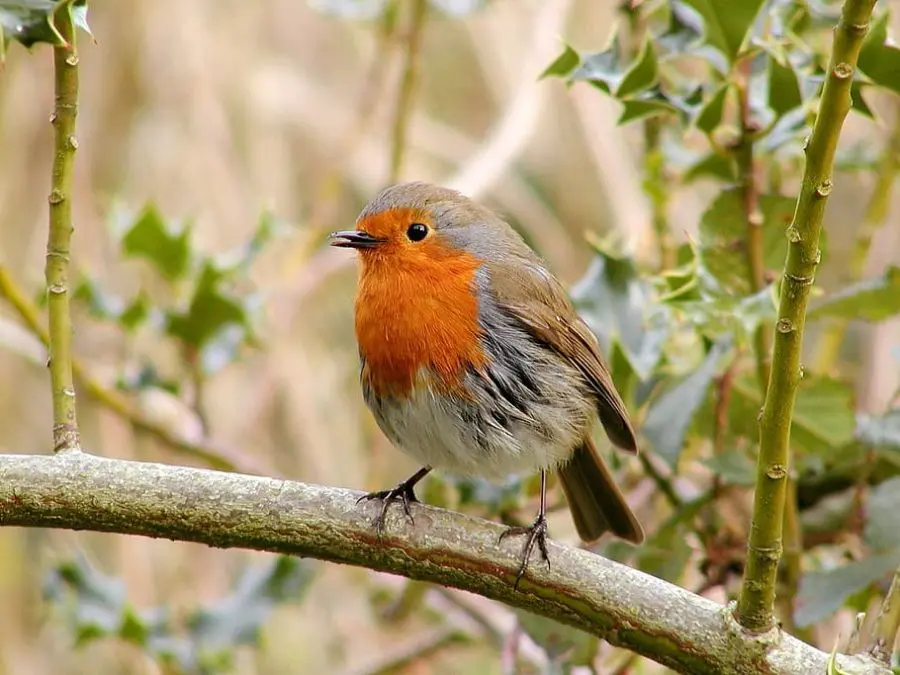
Hey there, nature lovers! Creating a wildlife-friendly garden is a wonderful way to support local wildlife and enhance biodiversity.
By providing food, shelter, and water, you can turn your garden into a haven for birds, butterflies, bees, and other creatures.
Let’s explore how to make your garden a wildlife-friendly paradise.
Creating a Garden That Supports Local Wildlife
Plant Native Species
Why Native Plants Matter: Native plants are adapted to your local environment and provide the best resources for local wildlife. Here’s why they’re important:
- Food Source: They offer natural food sources for pollinators, birds, and other wildlife.
- Habitat: Native plants provide shelter and nesting sites for various species.
- Low Maintenance: They require less water and care since they’re well-suited to the local climate.
Choosing Native Plants: Here are some native plant ideas:
- Flowers: Plant wildflowers like coneflowers, black-eyed Susans, and milkweed to attract pollinators.
- Shrubs: Use native shrubs like elderberry, serviceberry, and spicebush for birds and small mammals.
- Trees: Include native trees like oak, maple, and dogwood for birds and insects.
Provide Food and Water
Bird Feeders and Houses: Set up bird feeders and houses to attract and support local birds. Here’s how:
- Feeders: Offer a variety of feeders with seeds, suet, and nectar to attract different bird species.
- Houses: Install birdhouses suitable for species in your area, like bluebirds, wrens, and chickadees.
- Placement: Position feeders and houses in safe, quiet areas away from predators.
Water Sources: Provide clean water for drinking and bathing. Here are some ideas:
- Birdbaths: Set up birdbaths at different heights to cater to various bird species.
- Ponds: Create a small pond or water feature to support amphibians and insects.
- Water Dishes: Place shallow dishes of water for smaller animals and insects.
Create Shelter and Nesting Sites
Natural Shelter: Use natural elements to provide shelter. Here’s what to include:
- Brush Piles: Create brush piles from fallen branches and leaves for small mammals and insects.
- Rock Piles: Stack rocks to create hiding spots for reptiles and amphibians.
- Deadwood: Leave dead trees or logs in place to provide habitats for insects, birds, and fungi.
Artificial Shelters: Build or buy shelters for specific wildlife. Here are some examples:
- Bee Hotels: Install bee hotels to support solitary bees.
- Bat Houses: Mount bat houses to provide roosting spots for bats.
- Butterfly Houses: Place butterfly houses to offer refuge for butterflies.
Promote a Healthy Ecosystem
Avoid Chemicals: Minimize or eliminate the use of pesticides and herbicides. Here’s why:
- Pollinator Protection: Chemicals can harm beneficial insects like bees and butterflies.
- Soil Health: Natural soil ecosystems thrive without chemical interference.
- Water Quality: Prevent chemicals from leaching into water sources.
Compost and Mulch: Use organic compost and mulch to improve soil health. Here’s how:
- Compost: Create your own compost from kitchen scraps and garden waste to enrich the soil.
- Mulch: Apply mulch to retain moisture, suppress weeds, and support beneficial soil organisms.
Encourage Biodiversity: Plant a diverse range of species to create a balanced ecosystem. Here’s why:
- Pollinator Variety: Different plants attract various pollinators, supporting a healthy pollinator population.
- Pest Control: Biodiversity helps control pests naturally by encouraging predator species.
- Resilience: A diverse garden is more resilient to diseases and climate variations.
By implementing these wildlife-friendly gardening practices, you can create a vibrant, thriving garden that supports local wildlife.
Not only will your garden be a beautiful oasis, but it will also play a crucial role in promoting biodiversity and environmental health.
Happy gardening, and enjoy the company of your new garden visitors!
19. Climate-Resilient Gardening
Hey there fellow green thumbs! With the changing climate, it’s more important than ever to adapt our gardening practices to ensure our gardens thrive.
Climate-resilient gardening involves using strategies and techniques that help your garden withstand extreme weather conditions and changes in climate patterns.
Let’s explore how to make your garden more resilient to climate change.
Adapting Your Garden to Be Resilient to Climate Change
Choose Climate-Resilient Plants
Native and Drought-Tolerant Plants: Select plants that are naturally adapted to your local climate and can withstand periods of drought. Here’s why:
- Native Plants: These plants are adapted to local conditions and are more likely to thrive with less maintenance.
- Drought-Tolerant Plants: Plants like lavender, sage, and succulents can survive with minimal water.
Diverse Plant Selection: Plant a variety of species to create a more resilient garden. Here’s how:
- Biodiversity: A diverse garden is less susceptible to pests and diseases.
- Different Bloom Times: Plant species with varying bloom times to ensure continuous coverage and resilience throughout the year.
Water Management
Efficient Watering Techniques: Conserve water and ensure your plants get what they need. Here’s how:
- Drip Irrigation: Use drip irrigation systems to deliver water directly to the roots, minimizing waste.
- Mulching: Apply mulch to retain soil moisture, reduce evaporation, and keep roots cool.
- Water Harvesting: Collect rainwater in barrels and use it to water your garden.
Soil Health and Structure
Improve Soil Health: Healthy soil is more resilient to extreme weather. Here’s how:
- Organic Matter: Add compost and organic matter to improve soil structure and water-holding capacity.
- Cover Crops: Plant cover crops to protect and enrich the soil during off-seasons.
- Avoid Tilling: No-till gardening helps maintain soil structure and prevents erosion.
Microclimates and Shelter
Create Microclimates: Use structures and plant arrangements to create favorable growing conditions. Here’s how:
- Windbreaks: Plant trees or install fences to protect your garden from strong winds.
- Shade: Use shade cloths or plant taller plants to provide shade for sensitive crops.
- Raised Beds: Raised beds can improve drainage and protect plants from flooding.
Heat and Cold Protection
Protect Against Extreme Temperatures: Use these techniques to help your garden survive heatwaves and frosts:
- Mulch: Mulch acts as an insulator, keeping soil temperatures stable.
- Row Covers: Use row covers to protect plants from frost and intense sun.
- Watering Schedule: Water plants in the early morning or late evening to reduce stress during hot days.
Sustainable Practices
Reduce Carbon Footprint: Implement eco-friendly practices to minimize your garden’s impact on the environment. Here’s how:
- Composting: Compost kitchen scraps and garden waste to reduce landfill waste and enrich your soil.
- Organic Gardening: Use organic methods to manage pests and diseases, avoiding synthetic chemicals.
- Renewable Energy: Use solar-powered garden lights and tools to reduce energy consumption.
Monitoring and Adjusting
Stay Informed: Keep an eye on weather patterns and be prepared to adjust your gardening practices. Here’s what to do:
- Weather Updates: Regularly check weather forecasts to anticipate and prepare for extreme weather.
- Flexible Planting: Be ready to adjust planting schedules based on changing climate conditions.
- Observation: Regularly monitor your garden and make necessary adjustments to support plant health.
By incorporating these climate-resilient gardening practices, you can create a garden that not only survives but thrives in the face of climate change.
With thoughtful planning and sustainable techniques, your garden can be a resilient, bountiful space for years to come.
Happy gardening, and let’s make our gardens climate-resilient together!
20. DIY Garden Projects

DIY garden projects are a fantastic way to enhance your garden while embracing sustainability.
Not only do they add a personal touch to your space, but they also promote eco-friendly practices.
Let’s dive into some creative and sustainable DIY garden projects that you can start today.
Sustainable DIY Projects for the Garden
Upcycled Planters
Repurpose Household Items: Turn everyday items into unique planters. Here are some ideas:
- Old Tires: Paint and stack old tires to create colorful, sturdy planters.
- Mason Jars: Use mason jars for small herb gardens or succulent displays.
- Wooden Crates: Line wooden crates with landscape fabric and fill them with soil for rustic planters.
Vertical Gardens
Build Vertical Structures: Maximize your gardening space with vertical gardens. Here’s how:
- Pallet Gardens: Use wooden pallets to create a vertical garden by adding soil and plants between the slats.
- Hanging Pots: Hang pots from walls or fences to grow herbs, flowers, or small vegetables.
- Gutter Gardens: Mount old gutters on a wall or fence and plant shallow-rooted greens like lettuce and herbs.
Composting Systems
DIY Compost Bins: Create your own compost system to recycle kitchen scraps and garden waste. Here’s how:
- Wire Bin: Form a circle with wire mesh, secure it, and start adding compostable materials.
- Pallet Bin: Use wooden pallets to construct a three-sided compost bin, leaving one side open for easy access.
- Tumbler: Build a rotating compost tumbler from a barrel to speed up the composting process.
Rainwater Harvesting
Collect Rainwater: Set up a system to collect and use rainwater in your garden. Here’s what to do:
- Rain Barrels: Install rain barrels at the base of downspouts to collect runoff from your roof.
- DIY Diverter: Create a simple diverter to channel rainwater from gutters into your rain barrels.
- Soaker Hoses: Attach soaker hoses to your rain barrels to water your garden efficiently.
Garden Furniture
Build Eco-Friendly Furniture: Use sustainable materials to create garden furniture. Here are some projects:
- Pallet Furniture: Transform wooden pallets into garden benches, tables, and chairs.
- Log Benches: Use large logs or tree stumps to create natural seating areas.
- Reclaimed Wood: Build garden furniture from reclaimed wood to reduce waste and add charm.
Wildlife Habitats
Support Local Wildlife: Create habitats to attract beneficial wildlife to your garden. Here’s how:
- Birdhouses and Feeders: Build birdhouses and feeders from scrap wood to support local bird populations.
- Bee Hotels: Use bamboo sticks or drilled logs to make nesting sites for solitary bees.
- Butterfly Puddling Stations: Create shallow dishes filled with sand and water to attract butterflies.
Raised Garden Beds
Construct Raised Beds: Build raised beds to improve soil quality and accessibility. Here’s how:
- Recycled Wood: Use reclaimed wood to build the frame for your raised beds.
- Cinder Blocks: Arrange cinder blocks to form a sturdy, low-cost raised bed.
- Galvanized Tubs: Repurpose large galvanized tubs as raised garden beds for a modern look.
Garden Decor
Create Sustainable Decor: Add personality to your garden with eco-friendly decor. Here are some ideas:
- Wind Chimes: Make wind chimes from old silverware, keys, or other household items.
- Garden Markers: Use stones, wooden spoons, or broken pottery pieces as plant markers.
- Stepping Stones: Create personalized stepping stones using cement and decorative tiles or glass.
Soil Enrichment
Make Your Own Fertilizer: Create natural fertilizers to enrich your soil. Here’s how:
- Compost Tea: Steep compost in water for a few days to create nutrient-rich compost tea.
- Eggshell Fertilizer: Crush eggshells and sprinkle them around plants to add calcium to the soil.
- Banana Peel Fertilizer: Soak banana peels in water and use the liquid to water your plants, providing potassium and phosphorus.
These sustainable DIY garden projects are a great way to enhance your garden while being kind to the environment.
Get creative, have fun, and enjoy the rewards of your eco-friendly efforts. Happy gardening, and happy DIYing!
FAQ: Sustainable Gardening
Welcome to our FAQ section on sustainable gardening! Whether you’re just starting out or looking to deepen your knowledge, these answers will help you create a garden that’s eco-friendly and thriving.
Q: What does a sustainable garden look like?
A: A sustainable garden features a variety of native plants, uses compost and organic mulches, conserves water through rainwater harvesting and drip irrigation, and attracts beneficial wildlife.
It’s designed to work with the local environment, minimizing waste and chemical use.
Q: What plants are best for a sustainable garden?
A: Native plants are ideal for sustainable gardens because they are adapted to the local climate and require less water and maintenance.
Additionally, drought-tolerant plants like lavender, sage, and succulents, as well as perennial vegetables and herbs, are excellent choices.
Q: Which is the best example of a sustainable practice that might be used in a garden?
A: Composting is a prime example of a sustainable gardening practice.
It recycles kitchen scraps and garden waste into nutrient-rich soil, reducing the need for chemical fertilizers and improving soil health naturally.
Q: Why is home gardening sustainable?
A: Home gardening is sustainable because it reduces the need for transporting food over long distances, conserves water with efficient irrigation systems, and minimizes waste through composting.
It also promotes biodiversity and provides fresh, local produce.
Q: What is a self-sustaining garden called?
A: A self-sustaining garden is often referred to as a “permaculture garden.” This type of garden is designed to be regenerative and work in harmony with nature, requiring minimal external inputs.
Q: How do you build a self-sustainable garden?
A: To build a self-sustainable garden, start by planting native species and perennials, using compost and mulch to enrich the soil.
Incorporate rainwater harvesting systems, practice crop rotation and companion planting, and avoid chemical pesticides by using natural pest control methods.
Q: What is the difference between gardening and permaculture?
A: Gardening generally focuses on growing plants for food or aesthetic purposes, often using conventional methods.
Permaculture, on the other hand, is a holistic approach that designs agricultural ecosystems to be sustainable and self-sufficient, mimicking natural ecosystems.
We hope these answers help you on your journey to creating a sustainable and thriving garden. Happy gardening!
Introduction to Sustainable Gardening Conclusion
Gardening sustainably is a rewarding endeavor that not only provides fresh, nutritious food but also contributes to the health of our environment.
By adopting sustainable practices, you can create a vibrant, resilient garden that supports local wildlife, conserves resources, and fosters a deeper connection with nature.
Let’s summarize the essential points we’ve covered and highlight some key takeaways.
Recap of Key Topics
1. Composting Methods
Understanding and implementing different composting methods, such as traditional composting, vermicomposting, bokashi composting, and lasagna composting, can significantly enrich your soil and reduce waste.
2. Permaculture Principles
By applying permaculture principles, such as observing and interacting, using renewable resources, integrating rather than segregating, and catching and storing energy, you can create a self-sustaining garden that works in harmony with nature.
3. Rainwater Harvesting
Collecting and using rainwater efficiently through techniques like rain barrels, soakaway pits, swales, and rain gardens helps conserve water and ensures your plants get the natural hydration they need.
4. Sustainable Soil Management
Maintaining healthy soil through practices like composting, mulching, cover cropping, and crop rotation ensures your garden remains fertile and productive without relying on chemical fertilizers.
5. Organic Pest Control
Using natural pest control methods, such as encouraging beneficial insects, companion planting, neem oil, and diatomaceous earth, helps protect your plants while minimizing environmental impact.
6. Companion Planting
Strategically planting compatible species together can enhance growth, deter pests, and improve soil health, making your garden more resilient and productive.
7. Native Plants
Incorporating native plants into your garden supports local wildlife, reduces maintenance, and promotes biodiversity, creating a balanced and sustainable ecosystem.
8. Edible Landscaping
Designing a garden that produces food, by combining aesthetic and practical plants, maximizes space and resources while providing fresh produce.
9. Urban Gardening
Adopting urban gardening techniques, such as vertical gardening, container gardening, and efficient watering practices, allows you to grow a thriving garden even in small spaces.
10. Greenhouses and Cold Frames
Using greenhouses and cold frames sustainably extends your growing season and protects plants from harsh weather, ensuring a continuous supply of fresh produce.
11. No-Till Gardening
Practicing no-till gardening preserves soil structure, reduces erosion, and promotes soil health, making it a sustainable and labor-saving gardening method.
12. Seed Saving
Saving seeds from your garden helps maintain plant varieties, ensures a continuous supply of favorite plants, and promotes self-sufficiency.
13. Aquaponics and Hydroponics
Implementing aquaponics and hydroponics systems provides efficient, soil-less gardening methods that conserve water and space while producing healthy plants.
14. Community Gardens
Starting and participating in community gardens fosters social connections, provides access to fresh produce, and creates green spaces that benefit the entire community.
15. Wildlife-Friendly Gardening
Creating a garden that supports local wildlife enhances biodiversity and helps create a balanced ecosystem, making your garden a haven for beneficial creatures.
16. Climate-Resilient Gardening
Adapting your garden to be resilient to climate change through plant selection, water management, soil health, and sustainable practices ensures your garden thrives despite changing conditions.
17. DIY Garden Projects
Engaging in sustainable DIY garden projects adds a personal touch to your garden while promoting eco-friendly practices and resource conservation.
By embracing these sustainable gardening practices, you can create a garden that is not only productive and beautiful but also environmentally friendly.
Happy gardening, and may your green space thrive!




